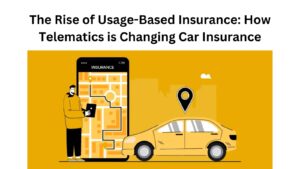Car insurance is essential for responsible vehicle ownership. However, many people have misconceptions. These misunderstandings can confuse, missed savings, or mistakes in coverage choices. Myths about car insurance have been shared for years. Some come from outdated or incomplete information. In this article, we’re going to bust the top five myths about car insurance that you should stop believing.

1. Myth: The Color of Your Car Affects Your Premium
Contents
- 0.1 1. Myth: The Color of Your Car Affects Your Premium
- 0.2 2. Myth: A Newer Car Is Always Cheaper to Insure
- 0.3 3. Myth: Car Insurance Is the Same Everywhere
- 0.4 4. Myth: Your Credit Score Doesn’t Affect Your Car Insurance Premiums
- 0.5 5. Myth: Minimum Coverage Is Enough for Everyone
- 1 Frequently Asked Questions
Reality: Your car’s color does not impact your car insurance premium.
This myth has existed for years. Many car owners believe that red cars cost more to insure. They think red cars are more likely to have accidents. The thought behind this is that sports cars or cars with bright colors attract more attention, leading to more accidents or theft. However, this is purely a myth, and insurance companies don’t even consider the color of your vehicle when determining your rates.
Why the Myth Exists: This myth probably started because sports cars, usually red, cost more to fix. They are often driven fast, which raises the chance of accidents. However, the color itself isn’t a factor in the risk assessment.
Real-Time Example: Imagine you drive a red sports car, and your neighbor drives a white sedan. Both of you are insured by the same company, and you both have identical driving histories. Your insurance premium won’t differ because of the color of the car. The factors that affect your rates are things like your driving record, the type of car, its safety features, and where you live.
Fun Fact: Studies show the most common car colors in accidents are white, black, and gray. Interestingly, red cars do not correlate with higher accident rates.
2. Myth: A Newer Car Is Always Cheaper to Insure
Reality: New cars can be more expensive to insure, not cheaper.
One of the most common misconceptions is that newer cars always cost less to insure than older cars. Some newer vehicles have advanced safety features that can lower insurance costs, but others may not. Newer cars, like luxury or sports models, often cost more to fix or replace. This can lead to higher insurance premiums.
Why the Myth Exists: The assumption is that a new car has fewer miles on the odometer and may be less likely to break down or experience mechanical issues. Newer cars seem more advanced, so drivers think insurers will offer lower rates for these features.
Real-Time Example: Take a new Tesla Model 3. It has great safety features and uses innovative technology. However, it costs more to repair due to its specialized parts and repair methods. Insurance companies consider these factors. Premiums for Tesla models are usually higher than for older cars, which are cheaper to repair.
Fun Fact: The most expensive cars to insure are often high-end sports cars, even if they’re new. For example, a new Porsche 911 costs around $3,000 per year for insurance, while a new Toyota Corolla costs about $1,500 annually.
3. Myth: Car Insurance Is the Same Everywhere
Reality: Car insurance premiums vary greatly depending on where you live, your driving habits, and other local factors.
Many people think that car insurance premiums are uniform across the country, but that couldn’t be further from the truth. The premium you pay depends heavily on where you live, your credit score (in many states), your driving history, and the car you drive. People in high-crime areas or busy cities often pay higher premiums. In contrast, those in rural or low-crime areas usually pay less.
Why the Myth Exists: Ads and online calculators give quick quotes, so it’s easy to think car insurance costs are steady. However, the location of your home, the accident rates in your area, and even the availability of repair shops can all influence premiums.
Real-Time Example: A driver in New York City might pay significantly more for car insurance than a driver in a rural town in North Dakota. In New York, traffic congestion and a higher risk of theft will naturally drive up the cost of car insurance, whereas in a smaller town, the risks are lower.
Fun Fact: In Michigan, car insurance costs are very high. This is because of its no-fault insurance system. Drivers must pay for their own injuries after an accident, even if they’re not at fault.
4. Myth: Your Credit Score Doesn’t Affect Your Car Insurance Premiums
Reality: Your credit score can have a significant impact on your car insurance premium in many states.
In 47 U.S. states, insurance companies can factor in your credit score when determining your rates. Drivers with lower credit scores often pay higher insurance premiums. This is because people with low credit scores tend to file more claims. This doesn’t mean that having bad credit will automatically prevent you from getting insurance, but it could lead to higher costs.
Why the Myth Exists: Many people don’t know that car insurance companies consider several factors when setting premiums. Credit scores are just one of these factors. Some states, such as California, Hawaii, and Massachusetts, don’t use credit scores to calculate rates. This makes people think credit scores aren’t a factor at all.
Real-Time Example: If you have a credit score in the range of 500-600, your premium could be significantly higher than someone with a score in the 700s. A driver with a good credit score may pay about $1,200 a year for car insurance. In contrast, a driver with poor credit could pay around $1,800 for the same coverage.
Fun Fact: The Federal Trade Commission says drivers with good credit can save up to 50% on insurance premiums compared to those with poor credit.
5. Myth: Minimum Coverage Is Enough for Everyone
Reality: Minimum coverage might not provide the protection you need in the event of an accident.
Many drivers believe that carrying the minimum required insurance coverage is sufficient. Minimum coverage might meet legal needs, but it often doesn’t offer enough protection in a serious accident. Minimum coverage typically includes liability insurance but may not cover damages to your own vehicle or medical costs beyond a certain limit. If you’re at fault in an accident, you could be personally liable for significant expenses that exceed the limits of your minimum coverage.
Why the Myth Exists: Minimum coverage is the cheapest option available, so it’s tempting for many drivers to assume that they don’t need anything more. However, this can be a risky decision if you don’t have a substantial emergency fund or if you drive a newer or more expensive vehicle.
Real-Time Example: Let’s say you have minimum coverage, and you’re involved in an accident where the damages exceed your liability limit. If the accident results in $15,000 in damages, but your minimum coverage is only $5,000, you might have to pay the extra $10,000 yourself.
Fun Fact: The average cost of a car accident in the U.S. is around $7,500 for property damage and medical expenses. In some states, this is higher than the minimum required coverage, which is often $25,000 in bodily injury coverage and $50,000 for all accidents in total.
MUST READ:
The Evolution of Life Insurance: From Term to Whole and Everything In Between
Frequently Asked Questions
No, the color of your car does not impact your car insurance premium. Insurers do not take the color of your car into account when calculating rates. Factors like the make, model, age of the car, your driving history, and the location where you live are the primary considerations for your premium.
In most states, yes, your credit score can affect your car insurance premium. Drivers with low credit scores usually face higher premiums. Studies show that those with poor credit often file more insurance claims. However, some states prohibit using credit scores to determine insurance rates.
Yes, if you’re at fault in an accident, your car insurance premium could increase. Insurance companies may raise your rates because they view you as a higher risk. If the accident wasn’t your fault, your premium might not go up. It could increase a little, depending on the situation and your insurer.
Is minimum coverage enough for my car insurance?
Minimum coverage can meet legal needs, but it may not offer enough protection in a serious accident. Minimum coverage usually includes liability insurance. This type of insurance pays for damage to others and their property. However, it often does not cover your damages. You may want to consider adding comprehensive or collision coverage for more complete protection.
Conclusion: What You Need to Know
Car insurance has many myths and misconceptions. It’s important to know the facts. This way, you can avoid overpaying or being underinsured. From the color of your car to the limits of your coverage, it’s important to separate fact from fiction. Debunking these myths helps you make informed choices about car insurance. This can save you money and give you the protection you need.
